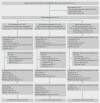Integration of balance and strength training into daily life activity to reduce rate of falls in older people (the LiFE study): randomised parallel trial
- PMID: 22872695
- PMCID: PMC3413733
- DOI: 10.1136/bmj.e4547
Integration of balance and strength training into daily life activity to reduce rate of falls in older people (the LiFE study): randomised parallel trial
Abstract
Objectives: To determine whether a lifestyle integrated approach to balance and strength training is effective in reducing the rate of falls in older, high risk people living at home.
Design: Three arm, randomised parallel trial; assessments at baseline and after six and 12 months. Randomisation done by computer generated random blocks, stratified by sex and fall history and concealed by an independent secure website.
Setting: Residents in metropolitan Sydney, Australia.
Participants: Participants aged 70 years or older who had two or more falls or one injurious fall in past 12 months, recruited from Veteran's Affairs databases and general practice databases. Exclusion criteria were moderate to severe cognitive problems, inability to ambulate independently, neurological conditions that severely influenced gait and mobility, resident in a nursing home or hostel, or any unstable or terminal illness that would affect ability to do exercises.
Interventions: Three home based interventions: Lifestyle integrated Functional Exercise (LiFE) approach (n=107; taught principles of balance and strength training and integrated selected activities into everyday routines), structured programme (n=105; exercises for balance and lower limb strength, done three times a week), sham control programme (n=105; gentle exercise). LiFE and structured groups received five sessions with two booster visits and two phone calls; controls received three home visits and six phone calls. Assessments made at baseline and after six and 12 months.
Main outcome measures: Primary measure: rate of falls over 12 months, collected by self report. Secondary measures: static and dynamic balance; ankle, knee and hip strength; balance self efficacy; daily living activities; participation; habitual physical activity; quality of life; energy expenditure; body mass index; and fat free mass.
Results: After 12 months' follow-up, we recorded 172, 193, and 224 falls in the LiFE, structured exercise, and control groups, respectively. The overall incidence of falls in the LiFE programme was 1.66 per person years, compared with 1.90 in the structured programme and 2.28 in the control group. We saw a significant reduction of 31% in the rate of falls for the LiFE programme compared with controls (incidence rate ratio 0.69 (95% confidence interval 0.48 to 0.99)); the corresponding difference between the structured group and controls was non-significant (0.81 (0.56 to 1.17)). Static balance on an eight level hierarchy scale, ankle strength, function, and participation were significantly better in the LiFE group than in controls. LiFE and structured groups had a significant and moderate improvement in dynamic balance, compared with controls.
Conclusions: The LiFE programme provides an alternative to traditional exercise to consider for fall prevention. Functional based exercise should be a focus for interventions to protect older, high risk people from falling and to improve and maintain functional capacity.
Trial registration: Australia and New Zealand Clinical Trials Registry 12606000025538.
Conflict of interest statement
Competing interests: All authors have completed the Unified Competing Interest form at
Figures
Comment in
-
Preventing falls in older people.BMJ. 2012 Aug 7;345:e4919. doi: 10.1136/bmj.e4919. BMJ. 2012. PMID: 22872696 No abstract available.
References
-
- Watson W, Clapperton A, Mitchell RT. The incidence and cost of falls injury among older people in New South Wales 2006/07. NSW Department of Health, 2010.
-
- Irwin M, Hayen A, Finch C. Methodological issues in using routinely collected electronic population mortality data: guidelines for using the national coroners information system for fatal injury surveillance in NSW. 2008. www.irmrc.unsw.edu.au/documents/NCISreport08.pdf.
-
- Sherrington C, Whitney JC, Lord SR, Herbert RD, Cumming RG, Close JCT. Effective exercise for the prevention of falls: a systematic review and meta-analysis. J Am Geriatric Soc 2008;56:2234-43. - PubMed
-
- NSW Department of Health. Annual report 2006/07. State Government of New South Wales, 2007.
Publication types
MeSH terms
LinkOut - more resources
Full Text Sources
Medical
Miscellaneous

